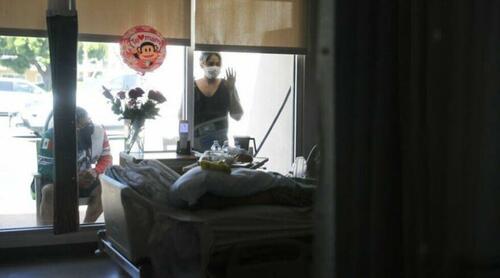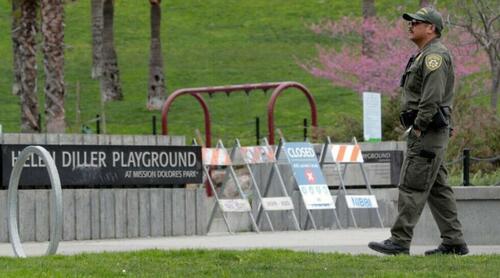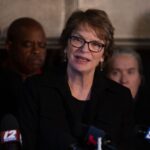
Authored by Julie Kelly via AmGreatness.com,
As we approach the third anniversary of “15 Days to Slow the Spread” there remains no accountability and no assurances that it couldn’t happen again...
Three years ago this week, our vibrant, noisy country went silent.
Or, I should say, it was silenced. Businesses didn’t shutter due to a sudden economic crash—although one quickly followed—and highways weren’t empty due to a global fuel shortage. Schools didn’t close because of a nationwide teacher’s strike; parents and children didn’t hunker down in separate rooms of the same house over a nasty family fight.
No, it was a man-made disaster the likes of which can only be compared to war. On March 16, 2020, President Donald Trump and his Coronavirus Task Force announced the infamous “15 Days to Slow the Spread.” For the first time in modern history, the free world, or so it was considered at the time, resorted to medieval methods to stop the unstoppable transmission of a novel contagion. Had there been enough time to farm a massive supply of leeches, the nation’s top government officials probably would have recommended bloodletting, too.
“The new recommendations are simple to follow but will have a resounding impact on public health,” the official White House announcement read.
“While the President leads a nationwide response, bringing together government resources and private-sector ingenuity, every American can help slow the virus’ spread and keep our most high-risk populations safe.”
It is a day, and a decision, that will live in infamy. Trump, of course, is not solely responsible; Drs. Anthony Fauci and Deborah Birx shrewdly won the affection and trust of the American people early on, so any move contrary to their counsel would have created an even bigger crisis in the White House. Prior to the official declaration, Republican governors warned shut downs were imminent. Congressional Republicans with a few exceptions—Rep. Tom Massie (R-Ky.) comes to mind—grasped the devastating impact on the most vulnerable, especially children, the poor, and the elderly. The national news media amplified the untested “mitigation” approach without a shred of skepticism.
Mario Tama/Getty Images
“We’re all in this together,” Hollywood insisted. Health care workers made up dances in between posting vicious condemnations aimed at any American who dared to question the scientific basis of indefinite home confinement. Doctors and nurses, in perhaps the cruelest act of all, forced patients to die alone as their loved ones stood helplessly nearby, but all too far away.
Public health “experts” became international celebrities simply by making up data and forecasting unrealized predictions of doom and death. Local police officers ran joggers off public beaches.
Carlos Avila Gonzalez/The San Francisco Chronicle via Getty Images
And it wasn’t just the professional class responsible for the dystopian hellscape.
Frustrated housewives chased down children who braved hazard-taped neighborhood playgrounds. When mask madness ensued, many of our countrymen built a mask militia of sorts, berating nonusers, or even those wearing their masks “improperly,” in public spaces. Indignant scolds posted their tirades on social media.
The list goes on and on. And as the pseudoscientific underpinnings—from the “natural” origins of the virus, to the official pronouncements on the effectiveness of social distancing, mask mandates, and vaccine efficacy—unravels under the weight of evidence, the collateral damage is gradually coming to light.
American teens remain trapped in an unprecedented mental health crisis, traumatized by months—and in some states, more than a year—of suffering social isolation, virus panic, and lost rites of passage leaving scars for a lifetime. A major study published in January detailed the global scale of the catastrophe.
“The effect of limited face-to-face instruction is compounded by the pandemic’s consequences for children’s out-of-school learning environment, as well as their mental and physical health,” according to a meta-analysis that reviewed more than two years of data related to school shutdowns.
“Lockdowns have restricted children’s movement and their ability to play, meet other children and engage in extra-curricular activities. Children’s wellbeing and family relationships have also suffered due to economic uncertainties and conflicting demands of work, care and learning. These negative consequences can be expected to be most pronounced for children from low socio-economic family backgrounds, exacerbating pre-existing educational inequalities.”
The full toll on children and families will likely never be known. Young adults attempt to navigate a new normal as “working remotely” persists in the white collar world. How can one make new friends or meet a prospective spouse when confined to a studio apartment in Lincoln Park working on accounting spreadsheets four days a week? (A recent college graduate told me how he was so excited during his first few weeks on the job to go into the office and finally meet his virtual co-workers that he picked up donuts to share. When he arrived, no one was there. So he gave the donuts to a homeless man outside the building.)
Life in most places, on the surface, appears to have returned to normal. Casual conversations often invoke “before COVID” to describe a time before March 2020. But in many respects, the “slow the spread” legacy lives. More than 110,000 restaurants closed permanently; it’s unclear how many have reopened. The service industry operates in constant fear history will repeat itself since no politician or government official has yet to suffer any repercussions for imposing such destructive—and futile—policies.
This applies to leaders of both parties. For proof, look no further than the resounding reelection victories of Governors Gretchen Whitmer (D-Mich.) and Mike DeWine (R-Ohio). (Safely reelected and considered a 2024 presidential prospect, should Biden choose not to run, Whitmer recently admitted maybe her harsh policies were “a little more than we needed to do.”)
And consider, too, the level of hero worship that still exists for Fauci in many quarters.
The issue promises to be a point of contention during the 2024 Republican presidential primaries. No current candidate has clean hands; in fact, former Vice President Mike Pence, who led the Coronavirus Task Force, arguably is most culpable. Florida Governor Ron DeSantis, undoubtedly one of the first leaders to recognize the futility and damage caused by the lockdowns, nonetheless instituted lockdown measures, supported mask use, and pushed vaccines.
In some ways, it’s hard to understand how this all happened.
None of it would have been possible but for the immediate and unskeptical submission of the overwhelming majority of Americans. Could it happen again? Sadly, the answer is yes.
Never again? We’ll see.
Authored by Julie Kelly via AmGreatness.com,
As we approach the third anniversary of “15 Days to Slow the Spread” there remains no accountability and no assurances that it couldn’t happen again…
Three years ago this week, our vibrant, noisy country went silent.
Or, I should say, it was silenced. Businesses didn’t shutter due to a sudden economic crash—although one quickly followed—and highways weren’t empty due to a global fuel shortage. Schools didn’t close because of a nationwide teacher’s strike; parents and children didn’t hunker down in separate rooms of the same house over a nasty family fight.
No, it was a man-made disaster the likes of which can only be compared to war. On March 16, 2020, President Donald Trump and his Coronavirus Task Force announced the infamous “15 Days to Slow the Spread.” For the first time in modern history, the free world, or so it was considered at the time, resorted to medieval methods to stop the unstoppable transmission of a novel contagion. Had there been enough time to farm a massive supply of leeches, the nation’s top government officials probably would have recommended bloodletting, too.
“The new recommendations are simple to follow but will have a resounding impact on public health,” the official White House announcement read.
“While the President leads a nationwide response, bringing together government resources and private-sector ingenuity, every American can help slow the virus’ spread and keep our most high-risk populations safe.”
It is a day, and a decision, that will live in infamy. Trump, of course, is not solely responsible; Drs. Anthony Fauci and Deborah Birx shrewdly won the affection and trust of the American people early on, so any move contrary to their counsel would have created an even bigger crisis in the White House. Prior to the official declaration, Republican governors warned shut downs were imminent. Congressional Republicans with a few exceptions—Rep. Tom Massie (R-Ky.) comes to mind—grasped the devastating impact on the most vulnerable, especially children, the poor, and the elderly. The national news media amplified the untested “mitigation” approach without a shred of skepticism.
Mario Tama/Getty Images
“We’re all in this together,” Hollywood insisted. Health care workers made up dances in between posting vicious condemnations aimed at any American who dared to question the scientific basis of indefinite home confinement. Doctors and nurses, in perhaps the cruelest act of all, forced patients to die alone as their loved ones stood helplessly nearby, but all too far away.
Public health “experts” became international celebrities simply by making up data and forecasting unrealized predictions of doom and death. Local police officers ran joggers off public beaches.
Carlos Avila Gonzalez/The San Francisco Chronicle via Getty Images
And it wasn’t just the professional class responsible for the dystopian hellscape.
Frustrated housewives chased down children who braved hazard-taped neighborhood playgrounds. When mask madness ensued, many of our countrymen built a mask militia of sorts, berating nonusers, or even those wearing their masks “improperly,” in public spaces. Indignant scolds posted their tirades on social media.
The list goes on and on. And as the pseudoscientific underpinnings—from the “natural” origins of the virus, to the official pronouncements on the effectiveness of social distancing, mask mandates, and vaccine efficacy—unravels under the weight of evidence, the collateral damage is gradually coming to light.
American teens remain trapped in an unprecedented mental health crisis, traumatized by months—and in some states, more than a year—of suffering social isolation, virus panic, and lost rites of passage leaving scars for a lifetime. A major study published in January detailed the global scale of the catastrophe.
“The effect of limited face-to-face instruction is compounded by the pandemic’s consequences for children’s out-of-school learning environment, as well as their mental and physical health,” according to a meta-analysis that reviewed more than two years of data related to school shutdowns.
“Lockdowns have restricted children’s movement and their ability to play, meet other children and engage in extra-curricular activities. Children’s wellbeing and family relationships have also suffered due to economic uncertainties and conflicting demands of work, care and learning. These negative consequences can be expected to be most pronounced for children from low socio-economic family backgrounds, exacerbating pre-existing educational inequalities.”
The full toll on children and families will likely never be known. Young adults attempt to navigate a new normal as “working remotely” persists in the white collar world. How can one make new friends or meet a prospective spouse when confined to a studio apartment in Lincoln Park working on accounting spreadsheets four days a week? (A recent college graduate told me how he was so excited during his first few weeks on the job to go into the office and finally meet his virtual co-workers that he picked up donuts to share. When he arrived, no one was there. So he gave the donuts to a homeless man outside the building.)
Life in most places, on the surface, appears to have returned to normal. Casual conversations often invoke “before COVID” to describe a time before March 2020. But in many respects, the “slow the spread” legacy lives. More than 110,000 restaurants closed permanently; it’s unclear how many have reopened. The service industry operates in constant fear history will repeat itself since no politician or government official has yet to suffer any repercussions for imposing such destructive—and futile—policies.
This applies to leaders of both parties. For proof, look no further than the resounding reelection victories of Governors Gretchen Whitmer (D-Mich.) and Mike DeWine (R-Ohio). (Safely reelected and considered a 2024 presidential prospect, should Biden choose not to run, Whitmer recently admitted maybe her harsh policies were “a little more than we needed to do.”)
And consider, too, the level of hero worship that still exists for Fauci in many quarters.
The issue promises to be a point of contention during the 2024 Republican presidential primaries. No current candidate has clean hands; in fact, former Vice President Mike Pence, who led the Coronavirus Task Force, arguably is most culpable. Florida Governor Ron DeSantis, undoubtedly one of the first leaders to recognize the futility and damage caused by the lockdowns, nonetheless instituted lockdown measures, supported mask use, and pushed vaccines.
In some ways, it’s hard to understand how this all happened.
None of it would have been possible but for the immediate and unskeptical submission of the overwhelming majority of Americans. Could it happen again? Sadly, the answer is yes.
Never again? We’ll see.
Loading…








